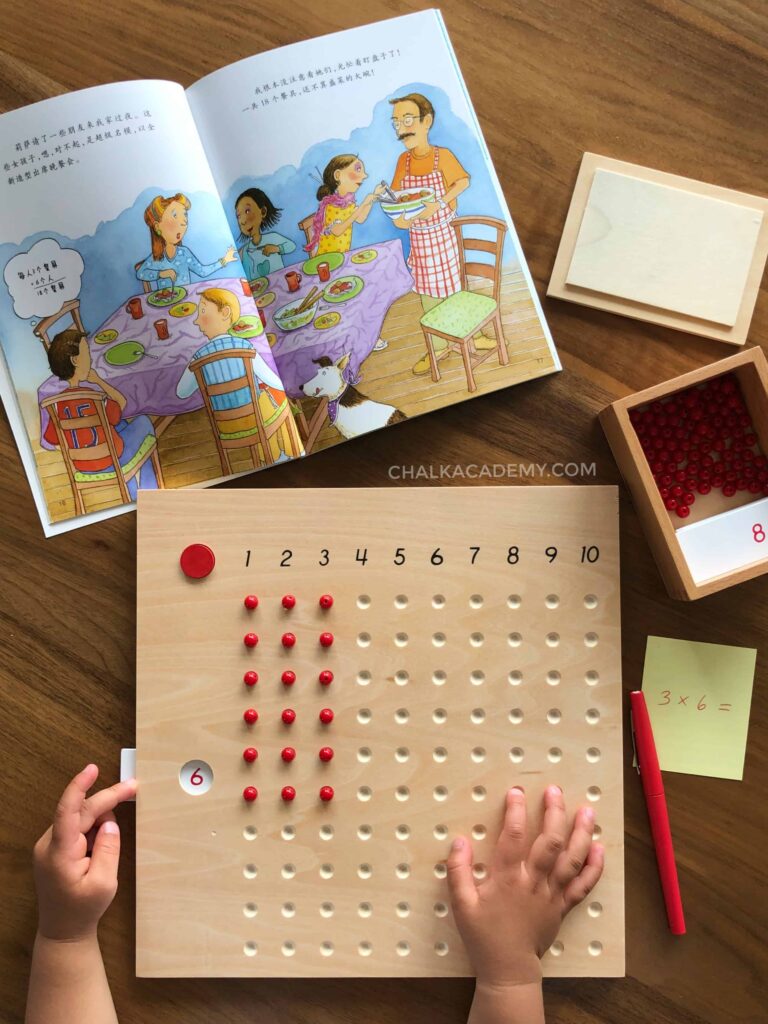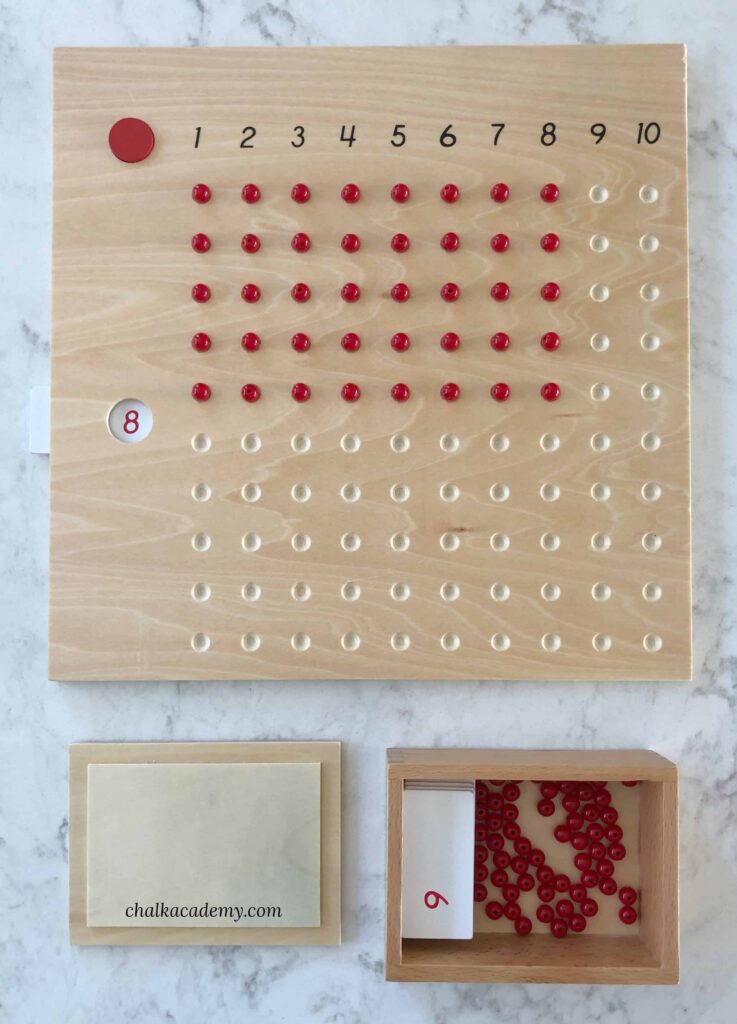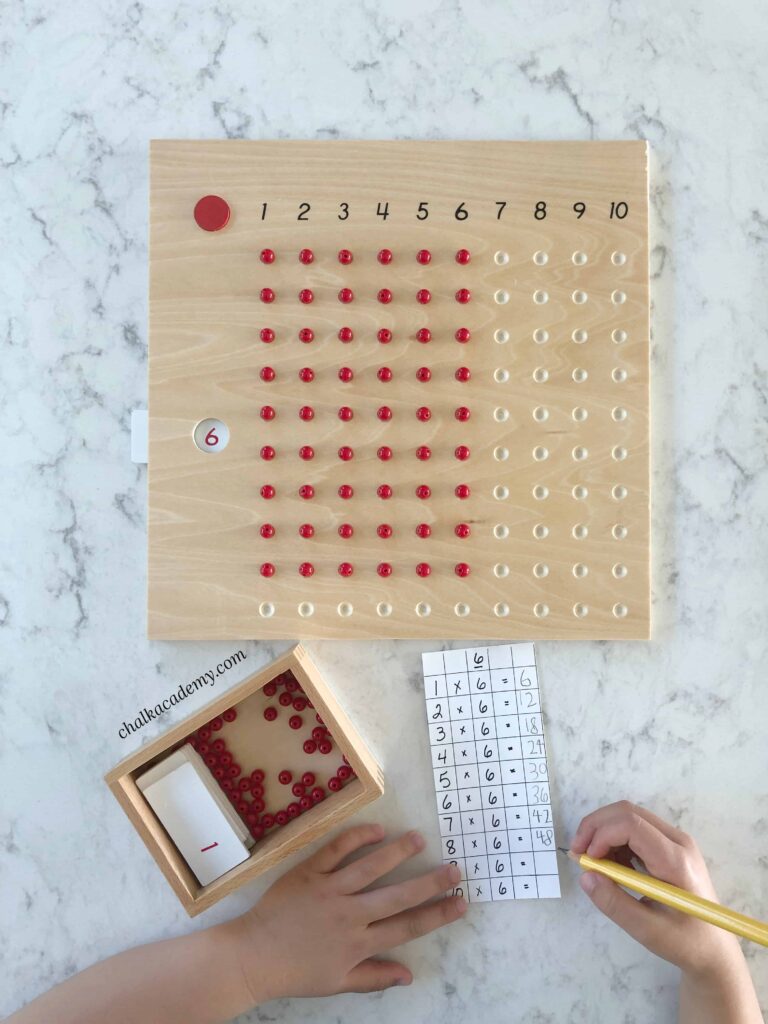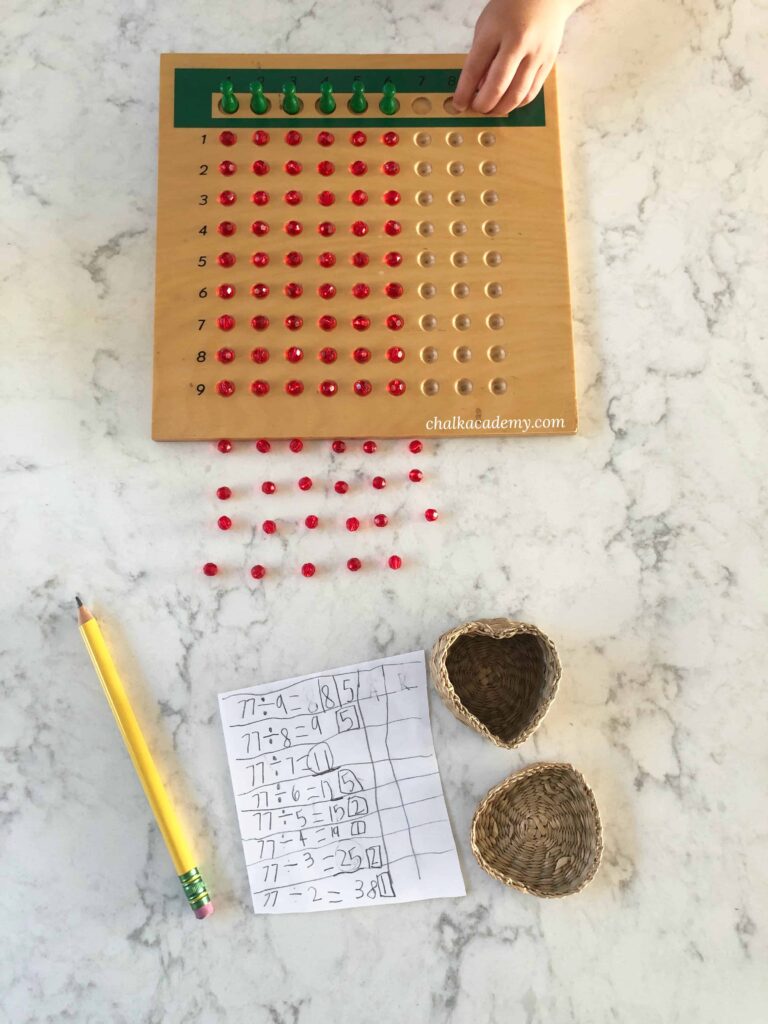Montessori Multiplication and Division Boards – Our Home Learning Experience

I was initially hesitant about buying the Montessori Multiplication and Division Boards. Through meal time, play, and other free, natural math learning opportunities in daily life, I had already introduced multiplication and division concepts to my 5-year-old daughter.
However, when our Montessori trainer presented these bead boards to my daughter, my daughter was immediately interested. This has been a useful math resource for her.
She’s has always been attracted to fine motor work with small beads, and these little pearls are wonderful for improving concentration while practicing math!
In this post, I’ll begin with our experience with using the Montessori Multiplication and Division Boards.
The end of the post has a video and references on how to use the Montessori bead boards plus where to buy them.

Chalk Academy is reader-supported. Some of the links are affiliate links. When you buy something through an affiliate link, we may earn a very small commission at no cost to you. Details here.
How we are using the Montessori multiplication and division bead boards
Flexible math schedule for my daughter
Over the past year, I have become relaxed about home learning. Although my daughter used to be self-motivated for academic learning with long periods of focus, she often wants to do whatever her 2.5-year-old brother is doing. Little brother is very active and wants to engage in cooperative play with her.
We don’t do math “formally” everyday, and my children certainly aren’t often seated peacefully on their mats like what you see in this photo! There is so much learning that happens on the go, but lately, I have been aiming for a 1-2 hour “work period” at home twice a week.
Unfortunately, this is below Montessori’s recommended 3-hour work period. The reality is that we have a lot of other things going on in our schedule, and my toddler son needs a lot of outdoor time during the day.
Related: Work-At-Home Bilingual Homeschool Schedule with 2 Kids (Printable)
Freedom of choice
Since my children generally get to choose the material they want to work on, freedom of choice encourages focus. My daughter is particularly attracted to the division board and finds the remainders fascinating!
Even if my son is running around in circles around her or pulls me away to play hide and seek, she will usually continue with her work. This is because she chose the work based on her own interest and not by parental force!

Using the Montessori multiplication and division boards with stories and real-life situations
In addition to using the Montessori bead boards in isolation, I always look for opportunities to tie in lessons with real life.
For example, if she’s reading our Chinese Math story books, I will pull Montessori materials that compliment the objectives.
Balancing teaching with siblings of different ages
Meanwhile, I try to prepare something developmentally appropriate for my son. After he spends a few minutes on “his” activity, he reeaalllyy wants to try big sister’s materials.
Safety for young toddlers
Although small beads are generally dangerous for children under age 3, he is past the mouthing stage.
With close supervision and reminders about where the beads should go, I let him explore the beads for fine motor work on a board that my daughter is not using. However, please do not leave these materials unattended with children under 3 or those who are mouthing objects.
Allowing children to get a “sneak peak” at more advanced Montessori materials
My son loves to show that he is a big boy and can do things just like his sister! If he is able to respect more advanced materials, I will let him touch and move as he wishes.
In return, my son is less likely to act out and disrupt his sister. In the next photo, my son even tries to put the Montessori multiplication board away by himself in the math section of the shelf!

Learning math bilingually in Chinese and English
These days, my children are mainly speaking Chinese and English together with relatively sporadic use of Korean.
Once a week, her Montessori tutor introduces math materials in English, including these multiplication and division boards. However, when she’s with me, she generally counts and calculates in Chinese.
Since my daughter and I have talked about basic math in Chinese since she was 3, she seems to associate math with Chinese language. Perhaps this will change over time if she ends up going to school full-time when she’s older.
Where to buy the Montessori multiplication and division boards
For a free overview of Montessori learning materials, you can take a look at this free Montessori Primary Guide. We have the following boards:
- Montessori Multiplication Board: includes wood board, red beads, number cards, red disc, and lidded wood box
- Montessori Division Board: includes wood board, green beads, green skittles, and lidded wood box
Please note that:
- This multiplication board is different from the Times Table and Pythagoras Board
- We are currently borrowing a Montessori division board from the Montessori teacher. The board is very old and missing the original green beads. Hence, there are red beads and a heart-shaped basket that you probably won’t find at typical Montessori stores.
Stores that sell the Montessori multiplication and division boards
- In the United States, you can find the Montessori materials at Amazon (here and here), Kid Advance, Leader Joy, and Alison’s Montessori.
- The best quality Montessori materials are from Neinhuis, which ships internationally, but the price tag is the highest.
DIY printable Montessori multiplication board
For those concerned about the cost of these materials, I just came across a clever printable Montessori-Inspired Multiplication Board on Nurturing Learning.
Instead of beads, they used red pushpins over a cork board. Since I have a 2.5-year-old son, I don’t really want him around pushpins, but I otherwise think it’s a brilliant cost-saving idea!
I have not seen a great DIY of the Division board, but I think you would need a longer cork board for remainders. You’ll see why toward the end of the post.
How to use the Montessori multiplication Board
Typically, multiplication and division are presented after a child has a strong grasp of addition and subtraction as well as work with the Montessori golden beads.
Here’s our Montessori Multiplication Board!

Our Montessori trainer had photocopied handwritten equations cut into mini worksheets as shown in the image below.

If there is interest from other families, I am thinking about making printable multiplication and division worksheets. At this time, we have a few more blank sheets to complete.
Please leave a comment or email me if you would be interested in this!

Otherwise, it’s been pretty easy to quickly write down a few equations. My daughter will even write her own equations!
However, if your child is overwhelmed by seeing multiple equations on one sheet, you can cut the paper and present equations individually. In contrast to traditional schooling, worksheets are often cut down in Montessori classrooms.
Video of the Montessori multiplication board
Here is a helpful overview of the Montessori multiplication board from The Pinay Homeschooler:
How to use the Montessori division board
Here’s a close-up of a very old Montessori division board! When you first present division to your child, make sure to offer equations with numbers that are evenly divisible.

After your child understands basic division, you can introduce remainders! As I mentioned previously, my daughter finds remainders to be fascinating! She is impressed with how long the beads can run under the board!
However, I noticed that she tends to make mistakes if she does work on our marbled dining table. In the image below, you can see that she made FOUR mistakes!!

Why did this happen? Because the beads were not perfectly aligned. Why did she not notice the misaligned beads?
- Designs on the marbled table compete visually with the beads.
- Slick surface allows for the beads to slip out of place.
In the next photo, we went back and doubled checked the work together, and my daughter corrected the answers.

The aforementioned mistakes demonstrate how errors can be prevented by using a Montessori work rug to anchor a learning activity. Scroll back to the top of the post to see how a neutral rug compares to the table!
Video of the Montessori division board
Here’s a helpful video from Montessori Works showing how to present the Montessori Division Board. I appreciate her practical tips toward the end, such as “You want something that’s going to excite your child.”
Prior to presenting the wood board, she recommends talking to your child about sharing (eg, food) with friends. These real-life analogies will help division be relevant and interesting to the child!
Have you used the Montessori Multiplication and Division boards for home learning?
I hope that your child can benefit from the Montessori Multiplication and Division Boards!
If you use these resources at home, please leave a comment below. We’d love to know how it goes for your family!
More mathematics resources for children
- Hundred Chart – 15 Fun Teaching Ideas in Chinese, Korean, and English
- 10+ Ways to Learn with a Wooden Montessori Hundred Board
- 15 Math Resources for Children Learning Chinese
Sorry that this isn’t related to the multiplication and division boards – I’ve been trying to figure out what the trays you have are (the one picture with the shelves). Can you tell me about them and where to get please? Thank you
Thank you for the post.
I have a set of ‘racks and tubes’ but the division boards that accompany the set are missing. Do you know where I could buy replacements?
Thank you.